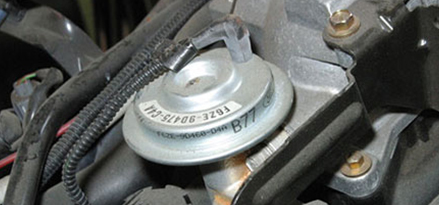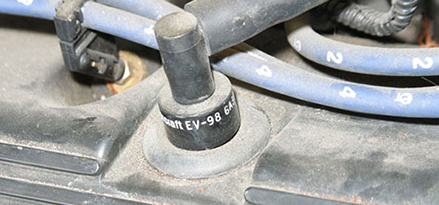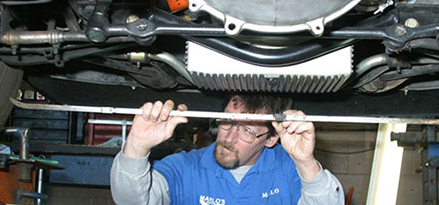By Jim Smart, www.automedia.com
Seems we've been focused on fuel economy for decades. And that's a good thing. The question then becomes how to get better gas mileage. If you want to know how to improve fuel economy, aim for the obvious in your fuel consumption habits and be willing to try what you haven’t tried. Here are some tips to keep in mind.
1: Tire inflation
It is an old saw but you would be amazed how many of us overlook this one. Tire pressure must be checked once a month. Most of us check it once a year and only if we see a bulging sidewall. Tire pressure must be maintained for fuel economy, and also for your safety. The latest thing is to inflate tires with nitrogen, which runs cooler and maintains pressure better than air. Checking tire pressure periodically when filling up is a
good habit to develop.
2: Modify driving habits
We've heard this one before, too, yet it applies now more than ever. Drive like there’s an egg between your foot and the accelerator. Drive with a light throttle, and do your best to stay in overdrive or final drive once you get rolling.
Other fuel economy driving tips include aiming for the smoothest pavement, which requires less power. Consolidate errands and take the UPS approach to planning each journey to the letter. Are you a left foot braker? Left foot brakers tend to ride the brake pedal while accelerating. Maintain a steady throttle and make finite adjustments to power.
-

3: Ignition timing
Ignition timing is always the subject of debate when it comes to both power and fuel efficiency. For optimum efficiency, you want ignition timing just shy of spark knock, where you achieve peak power and efficiency. You want to allow enough room for poor fuel quality and hot/high-load conditions, yet push the ignition timing as far as you can without doing engine damage.
4: Clean air filter
This one makes a lot of people sigh, but it remains an aspect of maintenance we don't check often enough. And if you live in the dusty and dry Southwest, air filters should be inspected frequently (monthly), when you check tire pressure.
-

5: Sensors inspected and replaced
Electronic engine control (EEC) sensors are the nerve endings of your fuel injection and ignition systems. Without them, your engine’s computer cannot do its job properly, if it can be done at all. Sensors include coolant temperature, intake air temperature, mass-air flow, throttle position, oxygen (O2), crank trigger, cam triggers, exhaust gas recirculation (EGR), manifold air pressure, evaporative emissions canister purge, and automatic transmission. Each of these sensors provides input the electronic engine control needs to provide proper engine function. Every 100,000 miles have all electronic engine control sensors checked and, if necessary, replaced for optimum performance and fuel economy. Follow your manufacturer’s recommendation.
6: Clean fuel injectors
Oh the endless debate addressing fuel injector cleaning and replacement. It is true fuel injectors can live indefinitely. Even the most neglected fuel injectors still perform valiantly because fuel injectors are largely self-cleaning. They rotate as they open and close, which cleans the needle and seat. And unless your automaker suggests injector cleaning, forget it. If you feel like you must replace fuel injectors, do it every 100,000 miles and sleep peacefully.
7: Own an older car? Install overdrive
If you own an older collectible car, especially one of the classic muscle cars, and desire better fuel economy for extended cruising, consider installing overdrive. There are complete turnkey manual five-and six-speed overdrive packages from Modern Driveline where you can do it all in one stop. Gear Vendors has bolt-on overdrive packages for a variety of vintage manual and automatic transmissions. These are stealthy overdrive systems you can install in a classic car and no one will know they are there but you. When in overdrive, your car will sip fuel rather than gulp it.
8: Get a dynamometer tune
Some car buffs visit dynamometer (dyno) shops all the time for real-world dyno tune performance in their quest for power. But did you know a custom dyno tune can also improve fuel economy? The key is to communicate what you want from the dyno tune. By recalibrating fuel and spark curves, fuel economy can improve along with power. What’smore, a good dyno shop can also find trouble items that require attention, such as O2 sensors, malfunctioning fuel injectors, a misfire and more. Do be sure that the work is done properly and that it doesn’t void your manufacturer’s warranty.
-

9: Sticking EGR valve
The EGR valve gets very little notice until it fails. And when it fails, it can cause a rough idle or an engine that won’t idle at all. The EGR valve cycles open and closed based on throttle movement and intake manifold vacuum to reduce exhaust emissions. If it sticks open due to carbon deposits and heat distortion, it creates a vacuum leak and rough operation. This will adversely affect fuel economy. Check your manufacturer’s recommendation for replacing the EGR valve.
10: Evaporative emissions
Your vehicle’s evaporative emissions control system indirectly affects engine function and fuel economy. The evaporative emissions system consists of vacuum hoses, a charcoal canister, and purge solenoids. The job of evaporative emissions is to trap fuel vapors in the tank and route them to the engine to be burned. With time and use, hoses become dry-rotted, the canister becomes contaminated, and purge solenoids can quit. If your vehicle has over 100,000 miles, check these parts and follow your manufacturer’s recommendation. You can replace 100 percent of the evaporative emissions system every 100,000 miles. This is the environmentally responsible thing to do and it will indirectly help fuel economy.
11: Fresh spark plugs
The "100,000 miles between scheduled tune-ups..." manufacturer’s claim has made us negligent. We believe automobiles are maintenance free aside from worn brake pads, tires, shock absorbers and filters. However, spark plugs should be replaced every 50,000 miles. Oh sure, you can get away with 100,000 miles and even more on a set of platinum tip spark plugs. However, as high-energy ignition systems hammer away on the cross electrodes, the gap gets wider and the spark less consistent and intense. Get yourself a fresh set of spark plugs for better gas mileage. And while you’re at it, check your coils and ignition harness.
12: Vacuum leaks
Vacuum leaks are easily one of the most overlooked malfunctions because we tend to think the worst and miss stray suckage completely. Oftentimes, vacuum leaks defy detection. Because so many operations beneath the hood depend on intake manifold vacuum, there are seemingly miles and miles of vacuum hoses from bumper to bumper.
Vacuum hoses dry rot, as do tees and other unions. And when they do, they create vacuum leaks, which can upset the electronic engine control system. O2 sensors pick up on lean conditions and enrich the mixture to compensate. You get a rough or unusually high idle and less power. The result is poor fuel economy.
-

13: Fuel pressure regulator
Fuel pressure regulators are typically life-of-the-vehicle components, but they can fail. Check your manufacturer’s recommendation, but it’s a good idea to change them every 100,000 miles to keep fuel pressure in the ball park and your vehicle on the road. A failed fuel pressure regulator can cause either too much fuel pressure or none. Too much means high fuel consumption and poor performance.
14: Ignition coils and harnesses
Again, we often hear the "100,000 miles between scheduled tune-ups" recommendation. High-energy ignition systems and sizzling underhood temperatures, however between scheduled tune-ups" recommendation. High-energy ignition systems and sizzling underhood temperatures, however, take a toll on ignition components. Coil-on-plug ignition systems have virtually eliminated ignition wires. However, there remain a lot of conventional coil pack and distributor ignition systems. When you change spark plugs, consider checking and, if necessary, changing ignition wires and coils while you’re in there. This keeps your entire ignition system fresh and on top of the business of ignition. As usual, check your manufacturer’s recommendation.
-

15: Crankcase ventilation
Most never consider the positive crankcase ventilation (PCV) valve in the same thought process as fuel economy, but it can have an effect. Every time you change your oil, check PCV valve function. With the engine at idle, pull the PCV valve out of the valve cover and check it for vacuum. The PCV valve keeps your engine’s crankcase ventilated and free of moisture and other contaminants. It can also be a huge vacuum leak source.
16: Fuel cap
An unsecured fuel filler cap will get you a Check Engine light on most late model vehicles. It will also cost you fuel economy because fuel has a high evaporation rate. A loose filler cap allows fuel vapors to escape, also causing the evaporative emissions system to malfunction.
17: Fans and fuel economy
Cooling fans can either enhance fuel economy or torpedo it completely. Inflexible steel fans rob you of power and fuel economy. The most efficient engine-driven cooling fan is the thermostatic clutch fan. It engages and functions when it is needed and freewheels when it isn’t needed. Electric thermostatic cooling fans remain the single greatest path to fuel economy. If you choose and size yours properly, you can get better cooling and improved fuel economy.
-

18: Still fooling with points?
If you drive a classic car and are still cruising the interstate with breaker points, you're burning excessive amounts of fuel. The Pertronix Ignitor electronic ignition conversion installs in 30 minutes and improves both drivability and fuel economy. Every time a spark plug misfires, it is precious fuel lost out the tailpipe. The Ignitor virtually eliminates misfire.
19: Live without air conditioning
When temperatures make the thermometer red, run your vehicle's air conditioning. However, we've gotten soft. Motorists run air conditioning even when temperatures are in the pleasant 70s because we like things constant. When temperatures fall into the 70s and even 80s, resist the urge to run air conditioning. If you have an older car with a big heavy piston compressor, consider changing over to a rotary cam plate-style Sanden compressor from Classic Auto Air, which is more efficient.
20: Friction reduction = fuel economy
Engine technology has brought us great aftermarket components that reduce internal friction, free up power and improve fuel economy. Roller camshaft and rocker arm technology improve fuel economy because they greatly reduce internal friction. If you take this logic even further with needle cam bearings and thrusts, you reduce friction even further. More generous piston to cylinder wall and bearing clearances will improve fuel economy, but pose some risk of premature wear.
21: Bolt-on electronic fuel injection
The aftermarket has brought us a wealth of great bolt-on technology for classic muscle cars. Enterprising companies like Edelbrock, Holley, and a host of others bring us electronic throttle body fuel injection that bolts in place of a carburetor. And if you install it properly, it can be stealthy so no one knows it is there but you.
22: Synthetic lubricants
Synthetic lubricants such as Mobil 1™ motor oil can provide better protection and performance than conventional motor oils. They also provide superior lubrication to moving parts, which can help those parts last longer. And because of their durability, you can drive a greater distance between oil changes. Synthetic lubrication improves fuel economy and frees up power.
-

23: Front-end alignment
Proper front-end alignment isn't just about drivability. It's also about rolling resistance and fuel economy. If your tires in all four corners are fighting with the pavement because they aren’t tracking properly, you're not only buying more fuel, you are sacrificing tire life. Overall rule of thumb with front-end alignment is a pinch of negative camber for good cornering and a pinch of toe-in for a good return to center after you turn a corner. If you are fighting the wheel, your tires are battling the pavement and consuming fuel.
24: Blocked catalytic converters
If performance is floundering and fuel consumption is up, chances are good that catalytic converters are blocked. Check with a reputable exhaust/smog shop and have your ‘cats’ checked for proper flow. Fuel economy gets lost via aclogged exhaust system.


